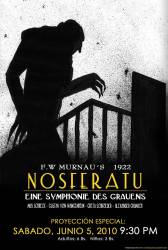Corrected entry: There is some debate over whether the beast frightening the horses in the Romanian village is a decorated hyena or a Tasmanian tiger, but neither is native to Romania.
Corrected entry: Though the movie is directly based on Bram Stoker's novel Dracula, with virtually identical plot points and characters, all the character names were changed to avoid copyright problems.
Correction: Although they tried to avoid copyright problems, they didn't manage it completely. A judge decreed that all copies and the negative had to be destroyed; however this was impossible to enforce in Germany and so a copy survived.
Corrected entry: In the final scene, as Orlock cringes from the sunlight which will destroy him, his reflection appears in the mirror behind him. The absence of reflection is key to vampire lore in this film.
Correction: The DVD commentary suggests that Orlok's reflection can be seen because the sun has robbed him of his powers. Also, the director uses the mirror deliberately to underpin a recurring doppelganger theme.
Corrected entry: Old Count Orlok seems to spend a lot of time in daylight. Walking around the ship and then carrying his coffin through the town at the end of his ship's journey.
Correction: Nosferatu is based on Bram Stoker's novel Dracula. In this novel, vampires are free to travel in daylight but cannot change shape during the day. Orlock wouldn't have any problems. The only way he can be harmed by sunlight is sunrise while feeding on a virgin sacrifice, as described by the book.






Correction: It's said that the woods and surrounding areas of Count Orlok's castle are haunted, so the animal frightening the horses could be a ghostly animal, a shape-shifting demon or something else supernatural.